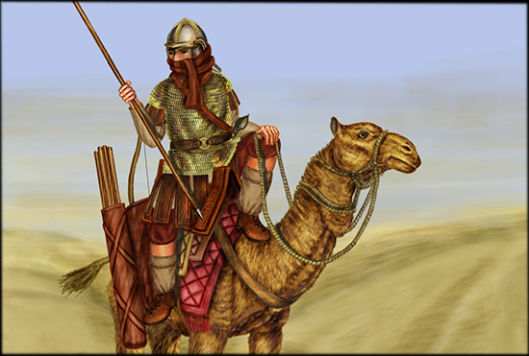
Dromedarii were first raised by Trajan and used as border scouts. Roman Dromedarii. Dromedarii are auxilliary troops recruited in the desert provinces of the Eastern Empire to take the place of light cavalry in scorching desert conditions.
As light troops these men are most useful as screening and scouting forces, although they can be surprisingly effective against other cavalry especially when the enemy horses are unused to the repulsive (to horses) smell of camels. Recruited from among the local desert tribesmen, dromedarii are peculiar to the Eastern Roman Empire and a specific answer to the problem of fielding light cavalry along the frontier.
Camel Riders (Dromedarii)
In the eastern provinces, Roman army units often contained a few camel riders, who were usually attached to a cohors equitata. Between thirty-two and thirty-six dromedarii are listed in the rosters of cohors XX Palmyrenorum equitata at Dura-Europos in the early third century, and one or two were sent on missions with the cavalry and infantry. An entire 1,000-strong camel unit, the ala I Ulpia dromedariorum milliaria, was raised by Trajan and stationed in Syria. There was no consistency in the organization of the dromedarii as either infantry or cavalry. This probably depended on the systems in place in each province. The 1,000 – strong unit just described was categorized as an ala, whereas the camel riders in cohors XX Palmyrenorum in Syria were attached to the infantry centuries. Their names were commonly listed at the end of each entry after all the other infantry soldiers, but in Egypt a dromedarius called Cronius Barbasatis was assigned to the cavalry turma of the decurion Salvianus. He was a volunteer and had not been transferred from another unit, so his skills were presumably recognized immediately on enlistment. However, it is generally considered that a dromedarius would usually enlist as an infantryman and serve for a few years in that capacity before becoming a camel rider.
Eastern auxilia, like those raised in the West, served throughout the empire. Local recruitment diluted a unit’s original ethnic content over time, but many units remained in the East. Syrian units, for example, served in Britain or Mauretania Tingitana but also in Palestine, Egypt, Cappadocia, or even in Syria. Vespasian (69-79) and Trajan (98-117) increased auxiliary cohorts of Roman citizens (units of volunteers often commanded by a tribune rather than a prefect) in the East, where a higher proportion of such to native (non-citizen) units and a greater number of citizens in non-citizen units are attested – perhaps a sign of higher professionalism in these units.
The East, however, did have peculiarities. The relative scarcity of water, especially in desert areas, encouraged use of camels. Corbulo’s dash from Syria (62) to relieve Caesennius Paetus, trapped by the Parthians at Armenian Rhandea, featured the first attested Roman use of camels as pack-animals. Within another century the Ps.-Hyginus (Mun. Castr. 29) could foresee camels on the Danubian frontier (possibly during Marcus Aurelius’ Marcomannic wars); camel bones appear in second- and third-century contexts in Pannonia Inferior. A turma or two of camel-riders (dromedarii) occur in some cohortes equitatae in Syria, Arabia, and Egypt. Trajan established the first regular camel unit, Ala I Ulpia dromedariorum Palmyrenorum; the Notitia attests three such alae of Diocletianic origin in Egypt. Their limited battlefield utility explains the slight number of dromedary units, although dromedaries operated throughout the southern theater as escorts, couriers, patrols, and in various police functions. The governor of Arabia supplemented his equites singulares with a guard of dromedaries.
Dromedaries directly reflect the southern theater’s needs, but other Eastern tactical peculiarities (e. g. archers, cavalry, cataphracts, phalangical infantry formation) only seem a response to Iranian opponents (Parthia, Sasanid Persia) and a legacy of Carrhae. A distinction should be drawn between what is eastern per se, what belongs to empire-wide tactical trends, and what constitutes a reaction to Iranian warfare. Herodotus’ exaggerated contrast of differing eastern and western styles of warfare in the Persian wars of the fifth century bc pictured Greek infantry’s superiority to Persian cavalry. The East was “horse country”: the name Cappadocia derived from the Persian for “land of beautiful horses”; Sophene and Armenia were horse-breeding areas and Median breeds were thought the best. The East’s vast expanses flavored mobile warfare and a fluid style of battle with missiles. If Alexander’s conquests asserted a role for heavy infantry in the East, generalship and superior skill in combined arms forged victory, not an Herodotean superiority of the spear to the bow. Seleucid and Pontic armies of the Hellenistic period retained a phalangical base, but both reverted over time to an Achaemenid Persian multi-ethnic force featuring native specialties. After all, Eumenes II of Pergamum’s cavalry, not Scipio Asiaticus’ legions, proved the decisive factor in Seleucid defeat at Magnesia (190 bc).